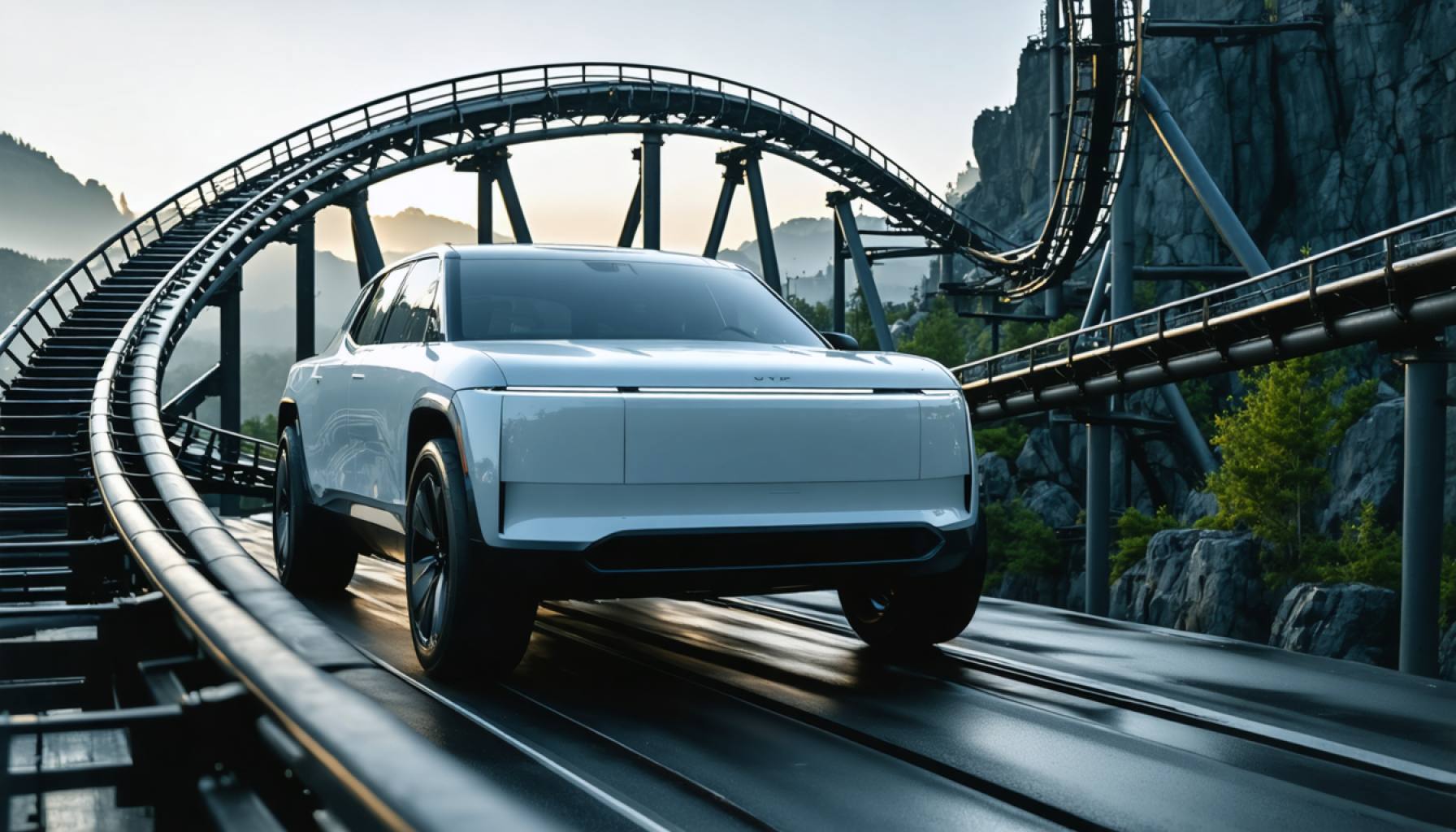- Rivian’s first-quarter 2025 deliveries fell to 8,640 vehicles, down from 14,183 in the last quarter of 2024.
- Production increased to 14,611 electric vehicles, up from 12,727, at its Normal, Illinois plant, indicating improved manufacturing capabilities.
- Despite delivery fluctuations, Rivian aims to meet its annual goal of delivering 46,000 to 51,000 vehicles in 2025.
- Rivian adjusts delivery rates, particularly for Amazon vans, balancing growth and sustainability.
- Rivian’s stock dipped by 2.8% amid market volatility, with attention on the upcoming first-quarter financial results.
- The key challenge for Rivian is managing production growth while setting realistic delivery expectations.
The landscape of electric vehicles shifts rapidly, much like the swift current of a river carving through stone, and Rivian Automotive is navigating these waters with a mix of triumph and trepidation. In a twist of fate that underscores the volatility of the auto market, Rivian’s first-quarter deliveries of 2025 slid to 8,640 vehicles, a noticeable drop from the robust 14,183 units dispatched in the final quarter of 2024. Yet, this apparent stumble doesn’t paint the entire picture.
Despite the drop in deliveries, Rivian’s production engine is humming with precision. The company’s workers in Normal, Illinois, where Rivian’s sprawling factory stands as a beacon of innovation, produced 14,611 electric vehicles during the first quarter. This uptick in production, from 12,727 vehicles in the previous quarter, highlights the company’s unwavering push to enhance manufacturing capabilities and meet ambitious targets.
Rivian reassures its stakeholders with a bold proclamation: it remains on pace to achieve its annual delivery goal of 46,000 to 51,000 vehicles in 2025. This confidence is rooted in a strategic recalibration, which sees the company adjusting the throttle on deliveries, particularly the delivery vans destined for Amazon. The retail giant enjoyed a bumper batch of these vans in the fourth quarter, but this year the pace slows, signaling Rivian’s broader commitment to balancing growth with sustainability.
Meanwhile, Wall Street’s reaction to this ebb and flow has not been without its own drama. Rivian’s stock price dipped by nearly 2.8% to settle at $11.21 per share, a testament to the broader market’s turbulent mood amidst tariffs and geopolitical uncertainties. Investors and analysts alike are poised with anticipation for the company’s first-quarter financial results, slated for release on May 6. These results will undoubtedly shed more light on Rivian’s fiscal health and steer its narrative for the rest of the year.
Amid these figures and forecasts, the key takeaway for Rivian lies in the delicate balancing act of scaling production while deftly managing delivery expectations. In the burgeoning market for electric vehicles, the path forward is not merely about speed but about strategic pacing and calculated growth. As Rivian maneuvers through this high-stakes landscape, its journey serves as both a cautionary tale and an inspiration for burgeoning automakers riding the electric wave.
Rivian’s EV Adventure: Navigating Growth and Market Challenges
Rivian: Balancing Production and Delivery for an Electric Future
Rivian Automotive has become a significant player in the electric vehicle sector, evidencing both innovation and the inevitable growing pains of a burgeoning company. The company’s recent performance captures the challenges and promises within the rapidly evolving EV market.
Rivian’s Recent Performance: A Closer Look
Despite a drop in Q1 2025 deliveries to 8,640 vehicles from 14,183 in the previous quarter, Rivian’s production efforts tell a different story. With a notable increase to 14,611 vehicles produced in Q1, the company is demonstrating a clear commitment to scaling its output. Rivian remains confident in meeting its ambitious annual delivery targets of 46,000 to 51,000 vehicles.
Key Questions About Rivian
What Contributed to the Drop in Deliveries?
The shift in delivery numbers is partly due to Rivian adjusting its delivery strategy, particularly concerning the Amazon delivery vans. In Q4 2024, Amazon received a substantial number of these vans, affecting future quota allocations.
How Has Wall Street Reacted?
Rivian’s share price fell by 2.8% to $11.21, reflecting broader market uncertainties. The upcoming financial results release on May 6 is highly anticipated to provide more insights into Rivian’s current fiscal health and future trajectory.
Industry Trends and Predictions
1. Uptick in EV Adoption: According to the International Energy Agency (IEA), electric cars will see significant adoption in the coming years, enhancing the competition Rivian faces worldwide.
2. Sustainable Manufacturing: Rivian’s focus on sustainable practices, such as its manufacturing plant in Normal, Illinois, is aligned with industry trends toward eco-friendly production.
3. Expansion of EV Infrastructure: With increasing support for EV infrastructure, Rivian stands to benefit from enhanced charging networks vital for long-term eco-friendly vehicle adoption.
Pros and Cons of Rivian EVs
Pros
– Innovative Design: Rivian’s vehicles are lauded for their sleek, user-friendly designs.
– Commitment to Sustainability: Rivian emphasizes sustainable production and vehicles.
– Strategic Partnerships: Collaborations with companies like Amazon bolster its market foothold.
Cons
– Production Challenges: As a rapidly growing company, scaling production without delays remains a challenge.
– Market Competition: Competing against established EV manufacturers is a continual challenge.
Actionable Recommendations
1. For Investors: Monitor upcoming financial results for insights into Rivian’s long-term potential.
2. For Consumers: Consider Rivian’s EV options for sustainable and innovative travel solutions.
3. For Rivian: Continue enhancing production efficiency and delivery strategies to meet growing demand.
Life Hacks for Prospective EV Buyers
– Assess Charging Infrastructure: Before purchasing an EV, evaluate local charging options to ensure convenience.
– Explore Incentives: Research government incentives for EV purchases that can provide significant savings.
For more information on electric vehicles and market trends, visit the [International Energy Agency](https://www.iea.org/). For more on Rivian’s latest news, check out their [official website](https://www.rivian.com).
